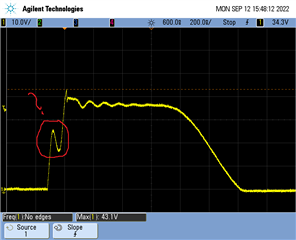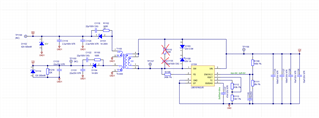Other Parts Discussed in Thread: LM5180EVM-DUAL
Hi,
we have custom board with dual output flyback design based on LM5181 with following parameters:
Vin nom= +12V
Vin range = 11V…13V
Vout1 = +12V /200mA
Vout2 = +56V / 5mA
Npr :Nsek1 = 2 :1
Nsek1:Nsek2 = 4.67:1
L = 110uH
Rpr = 0.268 ohm
Rsek1 = 0.066 ohm
Rsek2 = 2.8ohm
Dclamp = TVS SMAJ24A
Df= 30V 1A, Shottky
Snubber elements on primary side were not populated during measurements.
Remark: the same IC on the custom board was previously used with 500mW 22V Zener diode as clamping diode. The diode was working on the limit and it could be the case where IC was working for a while as the diode was broken. Since the IC was not replaced with the new one, we don’t know whether we also have an issue with the damaged IC that cause following results.
We measured SW pin and input ripple for different load current conditions. Some waveforms correlate with waveforms that could be found in LM5180EMV-S05, LM5180EVM-DUAL or in SNVAA28 (+/-18V Dual output) for heavy load condition.
However we have observed some strange behavior on SW pin for relatively small and medium loads between 25mA and 50mA where input ripple became quite higher as it was at heavy load. This lead to confusion as we tried to identify current Mode of Operation according to SW pin waveform which LM5181 currently work in. As it can be seen, the IC "jumps" between two operating modes even the load current was constant during the measurement time.
We had started with 1mA load at output 1 and no load at output2 measuring SW pin waveform only. The load was applied in steps of 10mA. Afterwards we added Vin ripple waveform and additional measurements where the ouput2 was loaded with 1.8mA and 3mA loaded respectively.
Could you advise us which of these 3 operating modes (FFM, DCM and BCM) the scope pictures Scope09... to Scope13... are related to? Is this normal behavior of sw pin where we have excessive ripple on the input voltage for some load values?
Or do we have here perhaps an issue with minimum Off-Time?
Is the diagram Figure 8-2. from datasheet on the page 10 valid for any output configuration, regardless whether it is single output, dual output, positive output configuration, negative output configuration?
What the Total Rated Output Power is related to, max. power of used transformer or to the max. power that LM5181 can handle (Primary switching current)?
We have also observed that the SW pin has less stable switching frequency (up to 10% jitter) and for 100mA load the measured SW frequency is 151kHz. This is also confusing since according to the figure 8-2 from data sheet it should not be less than 225kHz.
Electronic load was used during the test and SW pin was measured with grounded lead on scope probe. Only scope picture Scope42… was measured with short ground spring.
There is also a some kind of swinging on the rising edge of the SW pin. For the light loads it is located in the middle of the rising edge and it moves upwards as load increases. It will disappear at 90mA load.
Could you advise us where this swinging on SW pin could come from? 
Schematic:

Scope pictures:
TVS_SMAJ24A_without_Snubber.zip
Regards
Josko

